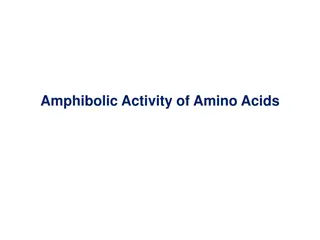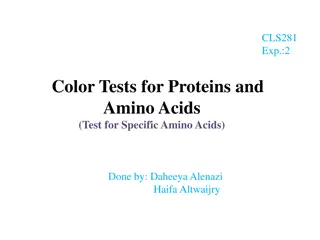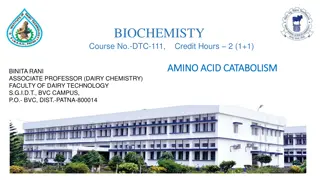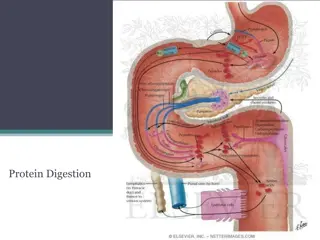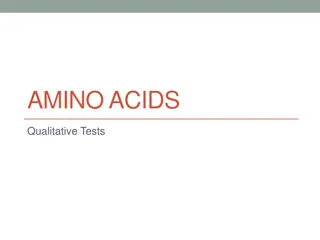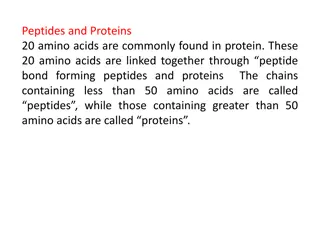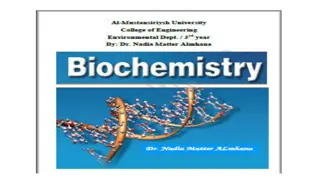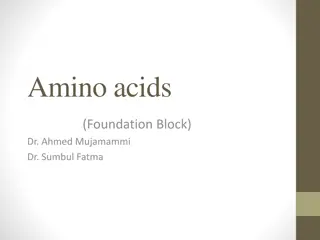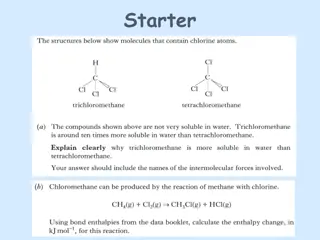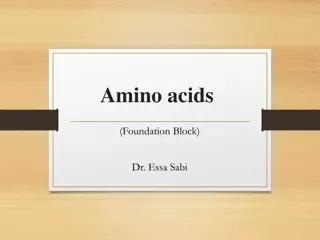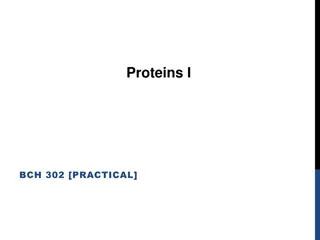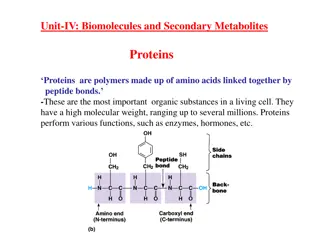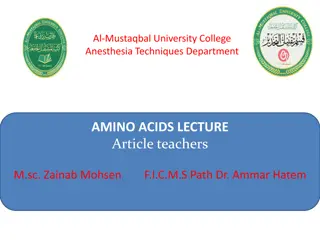Understanding Amino Acids, Peptides, and Proteins in Organic Chemistry
Amino acids, peptides, and proteins are essential components in biological processes. Proteins are polymers made up of amino acid units linked by peptide bonds, while peptides are important in various biological functions. The structure and classification of amino acids play a vital role in the structure, function, and reproduction of living matter. This chapter delves into the sources, classification, and structures of these fundamental molecules.
Download Presentation

Please find below an Image/Link to download the presentation.
The content on the website is provided AS IS for your information and personal use only. It may not be sold, licensed, or shared on other websites without obtaining consent from the author. Download presentation by click this link. If you encounter any issues during the download, it is possible that the publisher has removed the file from their server.
E N D
Presentation Transcript
Fundamentals of Organic Chemistry CHEM 109 For Students of Health Colleges For Students of Health Colleges Credit hrs.: (2+1) Credit hrs.: (2+1) King Saud University King Saud University College of Science, Chemistry Department College of Science, Chemistry Department CHAPTER 9: Amino Acids, Peptides and Proteins 1
Sources, Classification and Structure of Amino Acids o Proteins Proteins are naturally occurring polymers composed of amino acid units joined one to another by amide (or peptide) bonds. Example, Example, animal hair and muscle, egg whites, and hemoglobin are all proteins. o Peptides Peptides are oligomers of amino acids that play important roles in many biological processes. Example, Example, the peptide hormone insulin controls our blood sugar levels. o The The amino amino acids acids obtained from protein hydrolysis are -amino acids. o Proteins, Proteins, peptides, living matter. peptides, and and amino amino acids acids are essential to the structure, function, and reproduction of 2
Sources, Classification and Structure of Amino Acids o The The amino amino group group is on the - -carbon carbon atom atom, , the one adjacent to the carboxyl group. o With the exception of glycine, where R = H, a-amino acids have a stereogenic carbon carbon. . o All except glycine are therefore optically optically active o They have the L L- -configuration configuration relative to glyceraldehyde . . o Note Note that that the the Fischer Fischer convention convention, , used with carbohydrates, is also applied to amino acids. stereogenic center center at at the the - - active. . 3
Sources, Classification and Structure of Amino Acids o The The amino o Each also has a three of peptides, and a one-letter abbreviation used to describe the amino acid sequence in a protein. amino acids acids are known by common names. three- -letter letter abbreviation abbreviation based on this name, which is used when writing the formulas 4
Sources, Classification and Structure of Amino Acids List of the 20 -amino acids commonly found in proteins. 5
Sources, Classification and Structure of Amino Acids o The amino acids are classified into: Essential amino acids Eight amino cannot be synthesized by adult humans and therefore must be included in the diet in the form of proteins. e e. .g g. . Valine, Leucine, Isoleucine, Threonine, Methionine, Phenylalanine, Tryptophan, and Lysine. Non-essential amino acids Twelve amino acids can be synthesized in the body from other foods. e e. .g g. . Glycine, Alanine, Serine, Cysteine, Proline, Tyrosine, Aspartic acid, Glutamic acid, Asparagine, Glutamine, Arginine, and Histidine. 8
The AcidBase Properties of Amino Acids o The carboxylic carboxylic acid might ask whether they are mutually compatible since one group is acidic and the other is basic. o Amino Amino acids acids with one amino group and one carboxyl group are better represented by a dipolar ion structure. acid and and amine amine functional functional groups groups are simultaneously present in amino acids, and we o Amino Amino acids They can behave as acids and donate a proton to a strong base, or they can behave as bases and accept a proton from a strong acid. acids are are amphoteric amphoteric. . o The isoelectric isoelectric point point ( (pI pI) ), , the amino acid will be dipolar and have a net charge of zero. 9
Synthesis of Amino Acids Strecker Synthesis: Recall reductive amination and Cyanohydrin formation. 10
Reactions of Amino Acids 1) The Ninhydrin Reaction o Ninhydrin Ninhydrin is a useful reagent for detecting amino acids and determining the concentrations of their solutions. Ninhydrin is the hydrate of a cyclic triketone, and when it reacts with an amino acid, a violet dye is produced. o Only the nitrogen of the amino acid is converted to an aldehyde and carbon dioxide. o Only Only proline proline, , which has a secondary amino group, reacts differently to give a yellow too, can be used for analysis. nitrogen atom atom of of the the violet violet dye dye comes from the amino acid (primary amino group); the rest yellow dye dye, , but this, 11
Reactions of Amino Acids peptide bond bond) between the 2) Formation of an amide linkage (The peptide bond: Proteins) o Amino Amino acids carboxyl group of one amino acid and the -amino group of another amino acid. o A molecule containing only two amino acids (the shorthand aa is used for amino acid) joined in this way is a dipeptide dipeptide: acids are linked in peptides peptides and and proteins proteins by an amide bond (peptide The peptide peptide bond the amino acid with a free CO2- group at the right. These amino acids are called, respectively, the N N- -terminal amino acid. bond is written with the amino acid having a free +NH3 group at the left and terminal amino amino acid and the C C- -terminal terminal 12
Reactions of Amino Acids 2) Formation of an amide linkage (The peptide bond: Proteins) o We often write the formulas for peptides in a kind of shorthand by simply linking the three abbreviations abbreviations for for each each amino amino acid acid, , starting with the N-terminal one at the left. o For For example example; ; glycylalanine is Gly Ala, and alanylglycine is Ala Gly. three- -letter letter 13
Structure of Proteins o The The main - Primary Primary structure How many amino acids are present and what their sequence is in the peptide or protein chain. - Secondary, Secondary, tertiary, tertiary, and and quaternary quaternary structures structures; ; Three-dimensional aspects of peptide and protein structure, usually referred to as their. main features features of of peptide structure; ; peptide and and protein protein structure structure. . The Primary Structure of Proteins o The backbone backbone of of proteins proteins is a repeating sequence of one nitrogen and two carbon atoms. o Peptides Peptides and o An instrument called an amino and proteins proteins can be hydrolyzed to their amino acid components by heating with 6 M HCl. amino acid acid analyzer analyzer is used to determine the amino acids mixture. 14
Peptide Synthesis o Many methods have been developed to link amino acids in a controlled manner. To link the carboxyl group of one amino acid to the amino group of a second amino acid, we must first prepare each compound by protecting the amino group of the first and the carboxyl group of the second. o In this way, we can control the linking of the two amino acids so that the carboxyl group of aa1 combines with the amino group of aa2. 15


